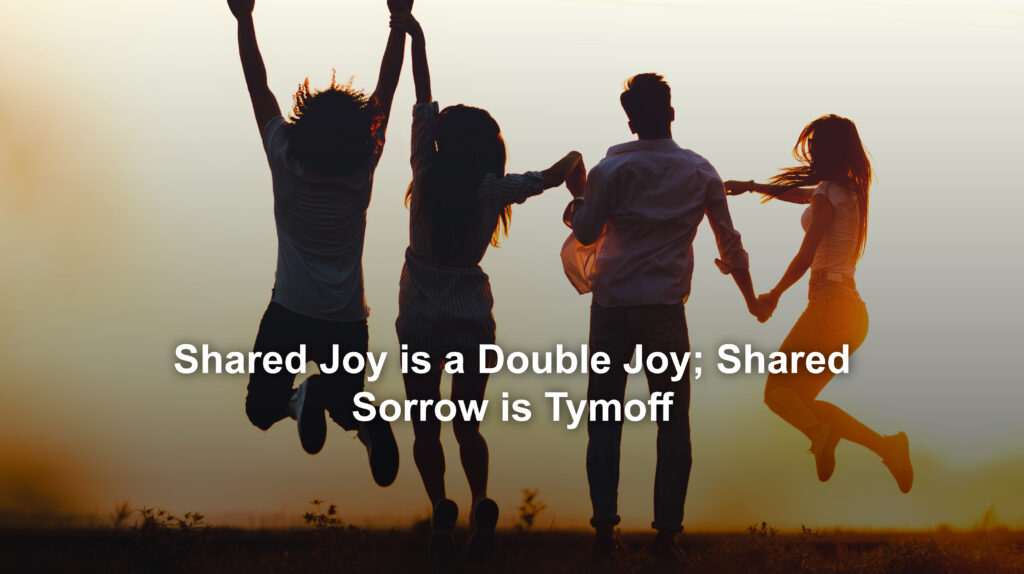The phrase “Shared joy is a double joy; shared sorrow is tymoff” is a powerful reminder of the human experience and the importance of connection in our lives. This concept is rooted in the idea that happiness, when shared, becomes more intense and fulfilling, while sorrow, when shared, becomes more bearable and easier to overcome. The origins of this proverb can be traced back to various cultures and philosophies that emphasize the significance of community and empathy in human interactions.
In everyday life, this saying holds great value as it reflects the deep emotional bonds that form when people come together in times of both joy and sorrow. The proverb suggests that sharing our emotions with others not only enhances the experience of joy but also provides comfort and relief during difficult times. It encourages us to open up to those around us, to celebrate our successes together, and to seek support when we are struggling. By doing so, we create stronger connections and build a sense of belonging that is essential for our overall well-being.
Table of Contents
The Psychological Benefits of Shared Joy
“Shared joy is a double joy; shared sorrow is tymoff” beautifully encapsulates the idea that happiness is not only a personal experience but one that thrives when shared with others. When we share our joy with someone, the positive emotions are amplified, creating a ripple effect that spreads happiness beyond ourselves. This phenomenon is supported by psychological research, which shows that sharing good news or positive experiences with others enhances our own sense of well-being and strengthens our social bonds. When we express our joy, it invites others to share in that happiness, creating a sense of community and mutual support. This shared experience of joy not only increases our individual happiness but also fosters a deeper connection with those around us.
Furthermore, sharing joy has been found to improve our mental health by reducing stress and anxiety. When we celebrate our achievements and happy moments with others, it reinforces our self-esteem and provides us with a sense of belonging. This social reinforcement is crucial for our emotional well-being, as it helps to combat feelings of loneliness and isolation. The act of sharing joy allows us to feel seen and valued, which in turn boosts our overall happiness. The concept of “shared joy is a double joy” is not just a saying; it is a fundamental aspect of human psychology that plays a critical role in our emotional and social lives.
Understanding “Shared Sorrow is Tymoff”
Just as sharing joy can amplify happiness, sharing sorrow can help to alleviate pain. The phrase “shared sorrow is tymoff” highlights the importance of empathy and emotional support in difficult times. When we share our sorrows with others, we are not simply unburdening ourselves, but also inviting others to help us carry the emotional load. This act of sharing sorrow creates a space for empathy, where others can understand our pain and offer comfort. It is through this mutual understanding and support that sorrow becomes more manageable, as the burden is no longer ours to bear alone.
Sharing sorrow is a vital part of the healing process. When we talk about our struggles and pain with others, it helps to process those emotions and find relief. The expression “shared sorrow is tymoff” suggests that by sharing our grief, we are able to diffuse its intensity, making it easier to cope with. Moreover, this shared experience of sorrow can lead to the formation of stronger emotional bonds, as those who support us during tough times become integral to our journey of recovery. The act of sharing sorrow is not just about seeking sympathy; it is about finding connection and understanding in our darkest moments.
Real-Life Examples: Shared Joy and Shared Sorrow
The impact of “shared joy is a double joy; shared sorrow is tymoff” can be seen clearly in various real-life examples where emotional experiences are shared within communities and families. For instance, consider a family celebrating the birth of a new child. The joy of the parents is not confined to them alone; it is shared with relatives, friends, and the community, creating a collective sense of happiness and excitement. This shared joy strengthens the bonds between family members and friends, as they come together to celebrate a significant moment in their lives. The joy becomes a communal experience, magnified by the number of people who share in it.

On the other hand, consider a community coming together to support a family who has lost a loved one. The sorrow felt by the grieving family is shared by the community, offering them comfort and support in their time of need. This collective sharing of sorrow helps to ease the pain of loss, as the family feels the warmth and empathy of those around them. Such examples illustrate the profound impact that shared emotions can have on our lives, reinforcing the idea that “shared joy is a double joy; shared sorrow is tymoff” is not just a saying but a reflection of human experience.
Practical Ways to Share Joy and Sorrow
To truly embrace the concept of “shared joy is a double joy; shared sorrow is tymoff,” it’s essential to actively seek out opportunities to share both happiness and sorrow with others. One practical way to share joy is by expressing gratitude and celebrating even small achievements with friends and family. Whether it’s a promotion at work, a personal milestone, or simply a good day, sharing these moments with others can enhance the joy and make it more meaningful. Additionally, participating in communal activities, such as group gatherings, celebrations, or even online social media platforms, can provide opportunities to share joy on a larger scale.
When it comes to sharing sorrow, the key lies in being open and vulnerable with those we trust. Talking about our struggles and seeking support from others can significantly reduce the emotional burden. It’s also important to be there for others when they are going through tough times, offering a listening ear or a helping hand. Simple acts of kindness, such as sending a comforting message or spending time with someone who is grieving, can make a huge difference in their healing process. By practicing empathy and compassion, we can create an environment where sharing both joy and sorrow becomes a natural part of our relationships, embodying the essence of “shared joy is a double joy; shared sorrow is tymoff.”
The Role of Social Media in Sharing Joy and Sorrow
In today’s digital age, social media plays a significant role in how we share emotions, both joyful and sorrowful. Platforms like Facebook, Instagram, and Twitter have become spaces where people express their happiness, achievements, and even their struggles. The concept of “shared joy is a double joy; shared sorrow is tymoff” is particularly evident on social media, where posts about joyous occasions, such as weddings, graduations, and personal victories, often receive an outpouring of likes, comments, and shares. This online validation and support can amplify the joy, making the experience even more fulfilling for the individual.
However, social media also provides a platform for sharing sorrow, where people can seek comfort and support from their online communities. Whether it’s through a heartfelt post about a personal loss or a call for help during difficult times, social media enables individuals to reach out to a broad audience, finding empathy and understanding in the digital world. While this can be incredibly beneficial, it’s important to use social media responsibly and be mindful of the impact that oversharing can have on both the individual and their audience. When used thoughtfully, social media can be a powerful tool for fostering the shared experiences that lie at the heart of “shared joy is a double joy; shared sorrow is tymoff.”
Conclusion
In conclusion, the phrase “shared joy is a double joy; shared sorrow is tymoff” captures the essence of human connection and the profound impact that sharing our emotions can have on our lives. Whether it’s the joy of a shared success or the comfort found in shared sorrow, these experiences are central to building strong, supportive relationships. By embracing the power of shared emotions, we not only enhance our own well-being but also contribute to a more empathetic and connected world. The simple act of sharing our joys and sorrows with others can transform our experiences, making the highs more exhilarating and the lows more bearable. As we navigate through life, let us remember the wisdom of this proverb and seek to share our emotions, knowing that in doing so, we enrich not only our own lives but also the lives of those around us.
